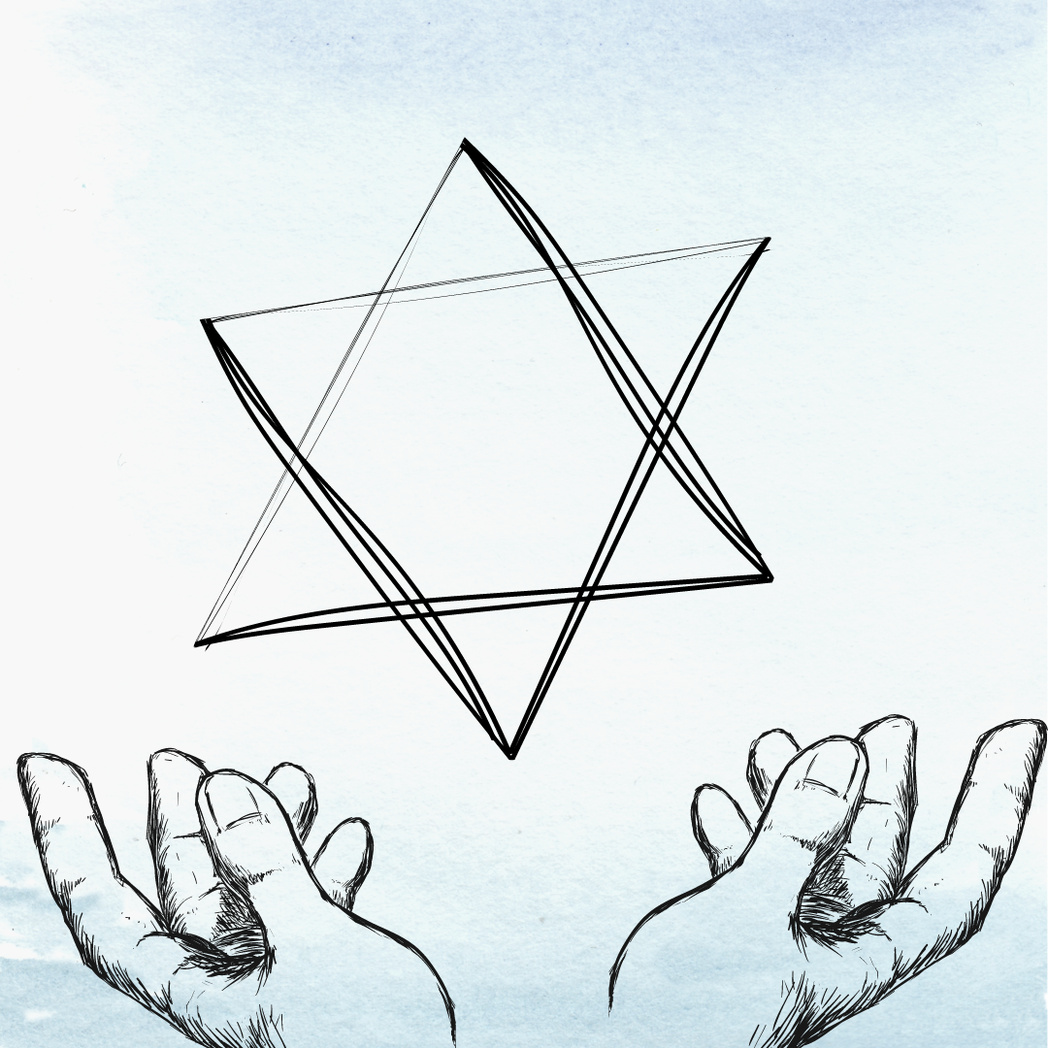One of the most well-known Jewish foods is challah, the bread eaten each week on Shabbat. It is customary to have two covered challot on the Shabbat table, resembling the double portion of manna that God provided for the Israelites before Shabbat in the wilderness:
(ד) וַיֹּ֤אמֶר יְהֹוָה֙ אֶל־מֹשֶׁ֔ה הִנְנִ֨י מַמְטִ֥יר לָכֶ֛ם לֶ֖חֶם מִן־הַשָּׁמָ֑יִם וְיָצָ֨א הָעָ֤ם וְלָֽקְטוּ֙ דְּבַר־י֣וֹם בְּיוֹמ֔וֹ... (ה) וְהָיָה֙ בַּיּ֣וֹם הַשִּׁשִּׁ֔י וְהֵכִ֖ינוּ אֵ֣ת אֲשֶׁר־יָבִ֑יאוּ וְהָיָ֣ה מִשְׁנֶ֔ה עַ֥ל אֲשֶֽׁר־יִלְקְט֖וּ י֥וֹם ׀ יֽוֹם׃
(4) And the Eternal said to Moses, “I will rain down bread for you from the sky, and the people shall go out and gather each day that day’s portion... (5) On the sixth day, when they apportion what they have brought in, it shall prove to be double the amount they gather each day.”
Before eating the challot, one removes the cover and recites HaMotzi:
(לא) בָּרוּךְ אַתָּה יְהֹוָה
(לב) אֱלֹהֵֽינוּ מֶֽלֶךְ הָעוֹלָם
(לג) הַמּֽוֹצִיא לֶֽחֶם מִן הָאָֽרֶץ:
(31) Blessed are You, Eternal,
(32) our Divinity, Royalty of the Universe,
(33) who brings bread out from the earth.
This tradition can be a beautiful reminder of the wonder of sustenance even when we are in the wildernesses of life.
Yet, for some people, HaMotzi can be a challenging encounter with the wilderness of disordered eating. How can we embrace HaMotzi as an opportunity to tap into wonder and gratitude for sustenance?
(יד) מַצְמִ֤יחַ חָצִ֨יר ׀ לַבְּהֵמָ֗ה וְ֭עֵשֶׂב לַעֲבֹדַ֣ת הָאָדָ֑ם לְה֥וֹצִיא לֶ֝֗חֶם מִן־הָאָֽרֶץ׃ (טו) ...לֶ֗חֶם לְֽבַב־אֱנ֥וֹשׁ יִסְעָֽד׃
(14) You make the grass grow for the cattle, and greenery for human labor to bring bread out from the earth (15) ... bread that sustains the human heart.
Rashi notes that the concept of sustaining one's heart with bread also shows up in Torah and Prophets:
(ה) וְאֶקְחָ֨ה פַת־לֶ֜חֶם וְסַעֲד֤וּ לִבְּכֶם֙...
(5) And let me fetch a morsel of bread so you can sustain your hearts...
(ה) ... סְעָ֧ד לִבְּךָ֛ פַּת־לֶ֖חֶם...
(5) ... Sustain your heart with a morsel of bread...
What does it mean for food to sustain your heart, physically and/or spiritually?
In addition to the texts above, you may incorporate the following wisdom from the Me'or Einayim, an 18th-century Jewish mystic, into your reflection:
...לאחר שאכל האדם המאכל ונשאר החיות בקרבו שהפסולת נדחה לחוץ מבלי חיות והוא דבר נפסד וגרוע כי עיקר המזון שהאדם ניזון ממנו ומוסיף לו כח הוא הניצוץ הקדוש שבמאכל ההוא שהוא הטעם הטוב שהאדם טועם במאכל ובמשקה ההוא ולכן בשעה שאוכל האדם המאכל נתייחד הניצוץ ההוא אל חיותו של האדם ההוא האוכלו וניתוסף בו כח. וכשמאמין אמונה שלימה גמורה שזה מזון רוחני שהוא אלהותו יתברך המלובש שם ונותן דעתו ולבו על פנימיות ומדבק את עצמו עם כל חיותו ומוחו ועם זה הכח והחיות שניתוסף בו על ידי הניצוץ הקדוש שבא בקרבו לשורש הכל שממנו נאצלו כל החיות אזי מביא גם כן הניצוץ הקדוש שהיה עד עכשיו בשבירה ובגלות אליו יתברך שהוא מתענג מאוד מזה כנודע כי זה כל עיקר עבודתינו לקרב כל הניצוצות הקדושות מן קליפיות שהן בשבירה אל מקום הקדושה...
When a person eats [something], the life-force ensconced within it, the holy spark, remains within the person. That spark unites with the person’s own life-force; through it they gain nourishment and strength. When that person has complete and absolute faith that this is also spiritual sustenance — Divinity's own self as garbed there — and is totally mindful of that inwardness, cleaving to the Root of all, the One from whom all life flows (and making use of the mental energy added to them by the power of that spark), they then bring that holy spark, until now broken and exiled, back to Divinity. Divinity, blessed may it be, rejoices greatly over this, since this is our essential task: to draw near all those sparks that had fallen and restore them to their holy place.
What an honor it is to be able to nourish our physical and spiritual beings, and, in doing so, to restore sparks to their divine homes. With each spark we restore, we are able to live more fully and freely.
When we say Hamotzi, we connect our own freedom with the freedom of our ancestors. Where does this show up in the text? The same Hebrew root for “hamotzi” (“who brings out [bread]”) describes the Israelites' liberation from Egypt:
... הוֹצִ֧יא יְהוָ֛ה אֶתְכֶ֖ם בְּיָ֣ד חֲזָקָ֑ה וַֽיִּפְדְּךָ֙ מִבֵּ֣ית עֲבָדִ֔ים מִיַּ֖ד פַּרְעֹ֥ה מֶֽלֶךְ־מִצְרָֽיִם׃
...the Eternal brought you out with a mighty hand and rescued you from the house of slaves, from the hand of Pharaoh, king of Egypt (Mitzrayim, the Narrow Place).
It is possible to consider Mitzrayim (from “tzar” or “narrow”) as a symbol of narrow places. What would it mean to find freedom from the narrow places of disordered eating?
This could involve expansively embracing sustenance, whether physical, psychological, or spiritual. It could also involve helping society embrace more functional attitudes around bread and food. Rabbanit Jennifer Kotzker Geretz reflects on HaMotzi's relationship with society:
"Crafting an Ideal Society" (Rabbanit Jennifer Kotzker Geretz)
…bread requires many things to come into existence – a time of peace long enough to be planted and harvested, a place to winnow and thresh the wheat, a mill or a grindstone, yeast, bowls, and time long enough for the bread to bake. Bread requires a human society functioning cooperatively and peacefully. When we give thanks for G-d’s bringing forth bread from the Earth in the “hamotzi” blessing, we are thanking G-d not only for the bread itself, but for the functional human society in which it was created.
HaMotzi is an opportunity to celebrate and contribute to freedom, peace, and healing. We can begin to create healing in our lives and those of others when we relate to bread, or food more generally, as that which sustains the physical and spiritual heart — that which uplifts divine sparks. Blessed is the divine liberation of bread from the earth, people from narrow places. May our bread sustain our bodies and souls.




